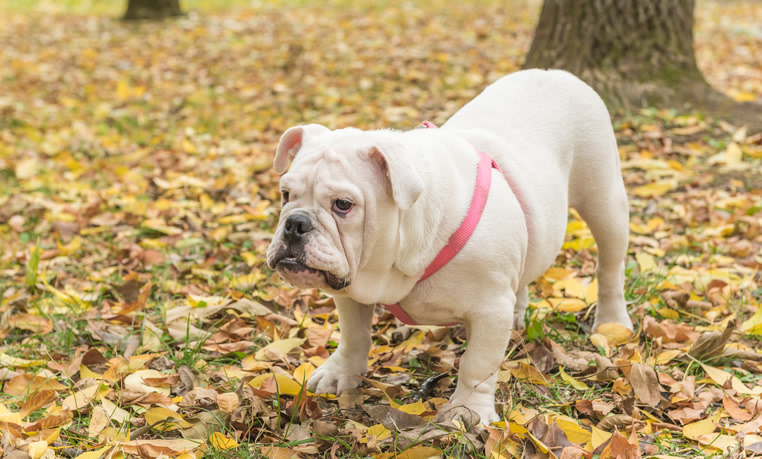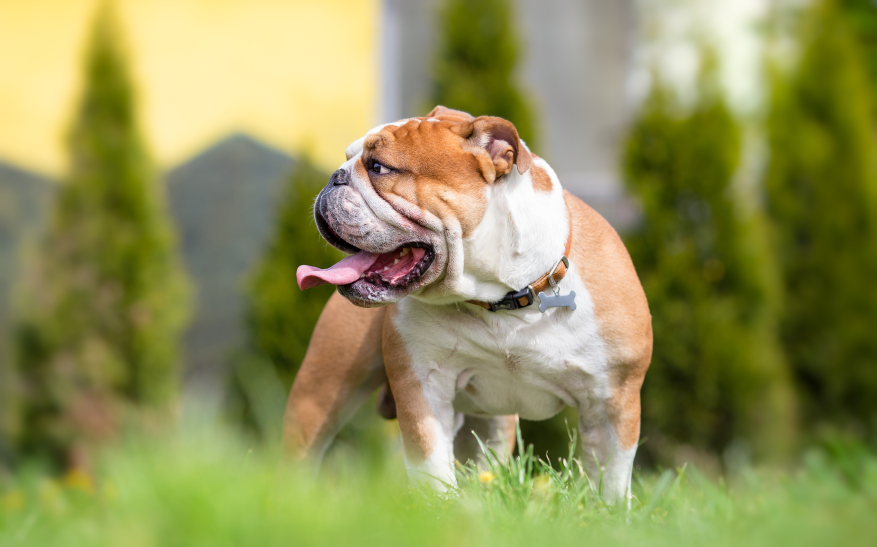Owning a deaf Bulldog is challenging yet rewarding. As humans, we are used to commanding dogs verbally and they oblige. However, things are a lot different when communicating with a deaf dog. Adjustments and learning new ways to communicate with a deaf dog are necessary to live a harmonious life together when your pet suffers from impaired hearing.

Causes of deafness in Bulldogs
There are many causes of deafness in Bulldogs, such as
- Congenital/ birth defect
- ruptured eardrums
- destruction or degeneration of ear canal
- ear infections
- cancer or tumors
- trauma
- physical damage to the ears
- medications
Congenital deafness is commonly seen in breeds with predominantly white, piebald, or merle coats. These breeds include Bulldogs, Bull Terriers, Collies, Shetland Sheepdogs, and dapple Dachshunds. Dogs with large white areas on the head have a higher chance of being deaf. Congenital deafness in Bulldogs and other canine breeds has been linked to the incomplete pigmentation of the hair on the coat.
Diseases, such as canine distemper, can also cause loss of hearing in Bulldogs. Some antibiotics, pain medications, and antiseptics can also cause idiopathic deafness in Bulldogs.
How to detect deafness in Bulldogs
When you are buying a Bulldog puppy, ask the breeder if the pup you intend to take home has deaf ancestors. A responsible breeder will never breed a dog with genetic problems. But if you suspect your Bulldog is deaf or has a low-hearing ability, you may look for the following signs.
- The pet does not respond to the sounds of squeaky toys.
- He does not get startled at loud and surprising noises.
- Your dog has difficulty in learning spoken commands
- The Bulldog shows indifference towards unusual or familiar sounds
- He often exhibits head shaking and ear pain.
- Your pet has a strong-smelling ear discharge.
- He does not wake up when called or when there is a sudden, loud sound.
Tips for Taking Care of Your Deaf Bulldog
A deaf Bulldog can live happily if he is well trained and taken care of properly. A few considerations must be made when caring for such a deaf dog, but these adjustments are not very difficult. Here are some tips to keep your deaf Bulldog safe and happy.
Keep your deaf Bulldog in a fenced yard
If your Bulldog is used to going potty outside, it is necessary to have your yard fenced once he loses his hearing ability. Puppies born deaf also need to be kept in a fenced area. There are far too many distractions outdoors. Because dogs are naturally geared toward detecting fast moving objects and your Bulldog could wander away and chase anything that catches his fancy. As he cannot hear you, you cannot simply call his name and expect him to come back. A deaf dog also cannot hear another dog or any vehicle approaching.
Put a bell on your deaf Bulldog’s collar
It can be pretty frustrating to find a dog who does not respond whenever you call him. Attach a bell to your deaf Bulldog’s collar. Doing so will help you keep track of his movements and whereabouts inside the house or around.
Use a flashlight to call your Bulldog
Dogs rely heavily on their ears, which is why clicker training is an effective method of training them. However, for deaf dogs, the closest alternative trainers and owners can use is the flashlight. You can use the tool to get your Bulldog’s attention, make him come to you, or signal him to start obeying to succeeding commands. Do not forget to reward your Bulldog with tasty treats every time he comes or responds to your signals.
Leash your deaf Bulldog when going out
Never let a deaf Bulldog walk outside without a leash to keep him safe and prevent him from encountering accidents and dangerous situations.
Teach your deaf Bulldog to respond to visual and touch signals
Deaf dogs cannot respond to verbal commands or sound cues. The best way to communicate with a deaf Bulldog is through visual and touch signals. The use of hand signals is common in training deaf dogs. Vibrating collars are also effective tools for training deaf dogs. However, many owners report seeing their deaf dogs feel uneasy while wearing it. Flashlights are another tool that is widely used in training deaf dogs.
Stomp on the floor when walking into the room of your Bulldog
Deaf dogs get startled easily because they cannot hear people or animals approaching them. They often get frightened leading them to respond aggressively. Stomp on the floor when walking into the room where your Bulldog is located. While he cannot hear your footsteps, he can sense you approach through vibrations.
Train your Bulldog to stay calm when he is suddenly touched
Sudden touches can scare a deaf dog. This could cause him to respond aggressively toward the person or animal who suddenly makes contact with the dog. Such aggressive behavior can be prevented by getting your Bulldog used to being touched. While resting together, tap your Bulldog’s legs and give him a treat. Wait for a few minutes or hours before repeating the act. Ask your family and friends to do the same so your Bulldog gets used to being suddenly touched or tapped by different people. This activity should help your deaf Bulldog associate sudden touch with receiving rewards, which could potentially lessen or stop him from being startled and aggressive.
Attach identification marks on your deaf Bulldog’s collar
It also helps to put a tag on your deaf Bulldog’s collar saying that he is hearing impaired. This way, people who find your Bulldog – in case he gets lost– are notified about his condition. Do not forget to put your contact details in your deaf Bulldog’s collar so that his rescuers can easily contact you.

